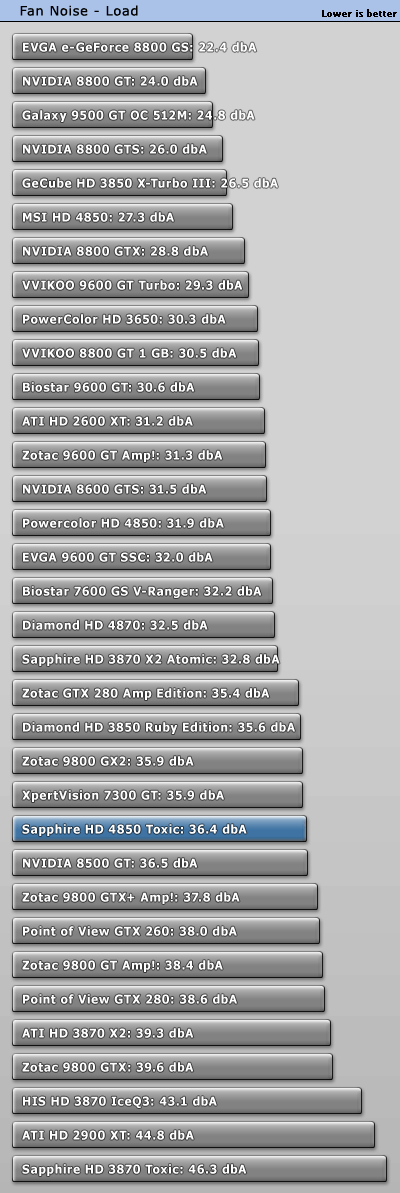 14
14
Sapphire HD 4850 Toxic 512 MB Review
Performance Summary, Perf/W, Perf/$ »Fan Noise
In the past years users would accept everything just to get more performance. Nowadays this has changed with people being more aware of the fan noise and power consumption of their graphic cards.In order to properly test the fan noise a card emits we are using a Bruel & Kjaer 2236 sound level meter (~$4,000) which has the measurement range and accuracy we are looking for.

The tested graphics card is installed in a system that is completely passively cooled. That is passive PSU, passive CPU cooler, passive cooling on the motherboard and Solid-State HDD.
This setup allows us to eliminate secondary noise sources and test only the video card. To be more compliant with standards like DIN 45635 (we are not claiming to be fully DIN 45635 certified) the measurement is conducted at 100 cm distance and 160 cm over the floor. The ambient background noise level in the room is well below 20 dbA for all measurements. Please note that the dbA scale is not linear, it is logarithmic. 40 dbA is not twice as loud as 20 dbA. A 3 dbA increase results in double the sound pressure. The human hearing is a bit different and it is generally accepted that a 10 dbA increase doubles the perceived sound level.
Sapphire has chosen to remove the temperature based fan control mechanism from their cooling solution. The fan will always run at the same speed, no matter if you run an idle system in Antarctica or under full load in the middle of the Saudi Desert. When asked, Sapphire replied that they "noticed that on many systems the problem is that the fan always starts and stops - at different temperatures. So we decided to always run at the same quiet fan speed".
This approach results in one of the noisiest cards under idle. When compared to the reference design HD 4850 the fan is 16.4 dbA noisier in idle - that's over 40x the sound pressure. Under load the margin gets smaller, yet the card cannot compare to the reference design when it comes to fan noise. However, the increased fan speed results in much lower temperatures and higher overclocking potential. Unfortunately power users won't be able to adjust the fan via any software. No matter what fan speed the card wants to run at the fan will always be around 1700 RPM.


Jul 13th, 2025 03:02 CDT
change timezone
Latest GPU Drivers
New Forum Posts
- Best motherboards for XP gaming (117)
- 9800x3D - 6400 CL32 1:1 not stable (13)
- Archival HDD constantly starting up for no reason (0)
- 6400c30 vs 8000c36 Ryzen 9800X3D (1)
- 9070XT BIOS flash (what to use?) (6)
- New ToS of Take Two and 2K (12)
- Radeon RX 6700, 6700 XT & 6750 XT users club (1138)
- Is there a WIFI chip I should get? (1)
- What are you playing? (23945)
- 9060 XT 16GB or 6800 XT/6900XT? (30)
Popular Reviews
- Fractal Design Epoch RGB TG Review
- Lexar NM1090 Pro 4 TB Review
- Corsair FRAME 5000D RS Review
- Our Visit to the Hunter Super Computer
- NVIDIA GeForce RTX 5050 8 GB Review
- NZXT N9 X870E Review
- Sapphire Radeon RX 9060 XT Pulse OC 16 GB Review - An Excellent Choice
- AMD Ryzen 7 9800X3D Review - The Best Gaming Processor
- Upcoming Hardware Launches 2025 (Updated May 2025)
- Chieftec Iceberg 360 Review
TPU on YouTube
Controversial News Posts
- Intel's Core Ultra 7 265K and 265KF CPUs Dip Below $250 (288)
- Some Intel Nova Lake CPUs Rumored to Challenge AMD's 3D V-Cache in Desktop Gaming (140)
- AMD Radeon RX 9070 XT Gains 9% Performance at 1440p with Latest Driver, Beats RTX 5070 Ti (131)
- NVIDIA Launches GeForce RTX 5050 for Desktops and Laptops, Starts at $249 (120)
- NVIDIA GeForce RTX 5080 SUPER Could Feature 24 GB Memory, Increased Power Limits (115)
- Microsoft Partners with AMD for Next-gen Xbox Hardware (105)
- Intel "Nova Lake‑S" Series: Seven SKUs, Up to 52 Cores and 150 W TDP (100)
- NVIDIA DLSS Transformer Cuts VRAM Usage by 20% (97)
